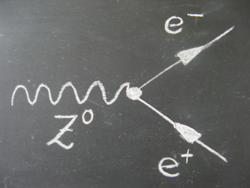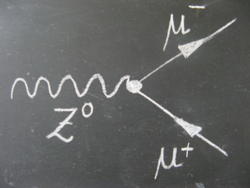Z events
Your challenge will soon be to select collisions where a Z boson was produced. But how can this be done when in reality the Z boson is a heavy particle that only lives for 3x10-25 seconds?
That is 0.0000000000000000000000003 seconds! No instruments are able to detect anything in that short a time.
How can you “see” the Z boson if it instantly disappears? Answer: By the knowledge of how it decays or "dies", and the Z boson can decay in a multitude of ways.
Naturally, the laws of Nature must be followed also in the process of Z decay. This means among other things, that since the Z boson is neutral (charge = 0), the charge of the decay products must equal 0. So if a Z boson decays to two particles, this must always be particle-antiparticle pair.
Adding up all the allowed types of lepton and quark combinations leads to 24 possibilities (!). Why 24? See here for more information. In our measurement we will however only focus on two of the “easiest” detectable decay-products, namely
- electron-positron pair
- muon-antimuon pair
The cartoon drawings visualize how the heavy Z boson transforms into a pair of such leptons.
It so happens that the electrons and muons (and their antiparticles) are stable enough for the detector to register them. This is crucial and makes the detection of short-lived particles like the Z boson possible.

